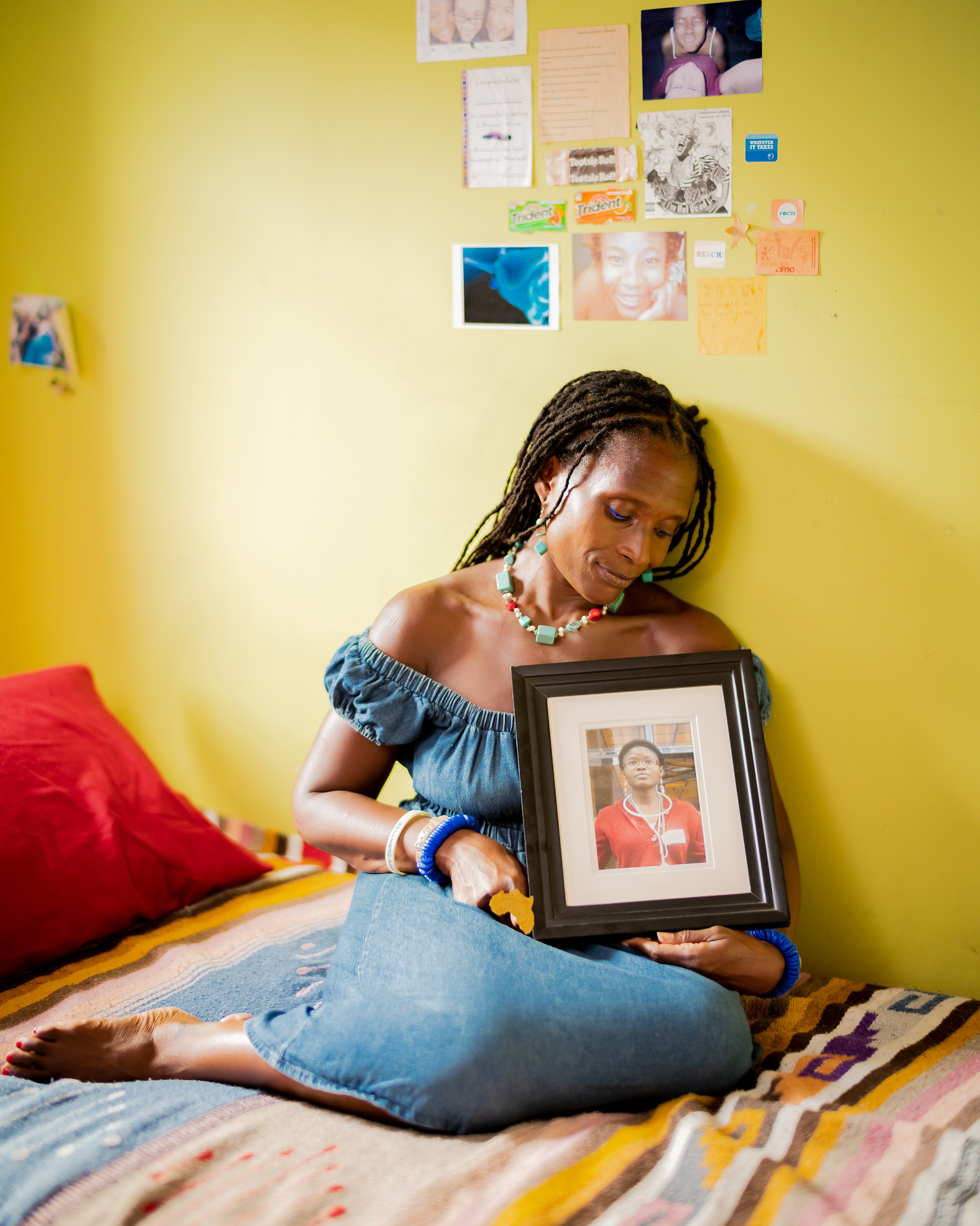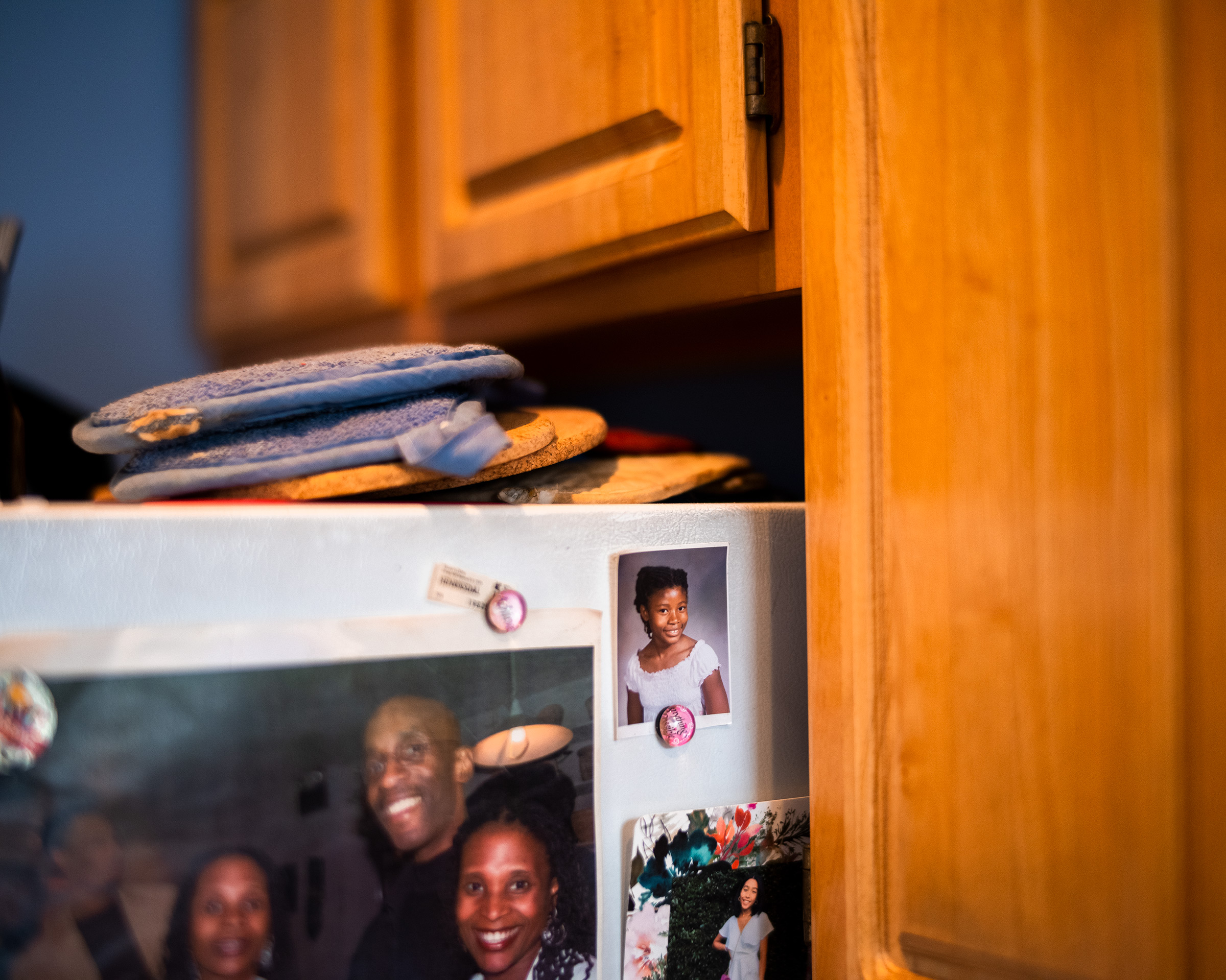When Dionne Monsanto was pregnant, she decided that she wanted to find a name that means “blessing” for her daughter. Though Monsanto—a Black American—has no specific ties to South Africa, she chose the name Siwe, an adaptation of the Zulu name Busisiwe.
Siwe grew to be a talented artist. “She was brilliant. She was beautiful. She was a writer. She was a guitar player. She was a dancer,” her mother says. Siwe was such a gifted dancer that, at age 10, she received a scholarship to the extracurricular program at the prestigious Ailey School in her hometown of New York City. But Siwe was also often troubled. From early on, Siwe “was very emotional, and would tend to cry a lot,” Monsanto says in the quiet of the Harlem studio where she used to teach yoga and West African dance before the studio closed due to the COVID-19 pandemic. Siwe was diagnosed with anxiety and depression at the age of 9. Schoolwork worsened her anxiety. But, Monsanto says, most adults and peers in her daughter’s life didn’t have much awareness of mental-health issues, and were ill-equipped to help.
“What I would get from doctors was like, ‘Well, she’s a girl, you know, her period is starting’—dismiss,” says Monsanto. But she knew there had to be something more going on. “I couldn’t identify it,” Monsanto says, “but I felt it.” Then, in the summer of 2011, at the age of 15, Siwe took her own life.

In the 10 years since Siwe died, stories like hers have become all too common. Across the board, suicide rates among young Americans have risen; from 2007 to 2018, suicide rates for Americans ages 10 to 24 rose by 57%, and the increase was particularly significant among young girls, contributing to a narrowing of the persistent suicide gender gap. Rates plateaued from 2018 to 2019—the most recent year with available federal data—but they stood far higher than those of decades past. A multinational study published in the Lancet Psychiatry in April found that U.S. suicide rates actually decreased somewhat during the early months of the pandemic, compared to the year before it—but given spiking anxiety and depression rates during the pandemic, which studies suggest took a particularly harsh toll on young people, there’s good reason for continuing concern.
Girls of color are increasingly accounting for this trend. According to one 2019 Pediatrics study, the number of white children attempting suicide in the U.S. decreased from 1991 to 2017, while the number of Black children attempting suicide went up. All told, about 15% of Black female high school students attempted suicide in the year leading up to the CDC’s 2019 Youth Risk Behavior Survey, compared to about 9% of white female students and about 12% of Hispanic female students. Actual suicide death rates for Black American girls ages 13 to 19 increased by 182% from 2001 to 2017, according to a 2019 study published in the Journal of Community Health.
“Black youths are two times more likely to die by suicide compared to their white counterparts,” says Arielle Sheftall, a researcher at the Center for Suicide Prevention and Research at Nationwide Children’s Hospital in Columbus, Ohio, and one of the authors of the 2019 Pediatrics study. Now, she says, “we’re trying to figure this out.” There’s rarely a single thing that drives someone to attempt suicide, and similarly there are many factors—from bullying to stigma to childhood trauma and racism—but no one cause that could help to explain the increase in suicides among Black youth. “We want to intervene, but we don’t know what the best intervention is yet,” Sheftall says. “It’s going to take a village, to be honest, to uncover what” could help reverse the trend, particularly when no two suicide deaths are exactly alike.
In Siwe’s case, there may have been a devastating trigger. When she was 11, she was sexually assaulted by her father, from whom Monsanto had separated eight years earlier but was co-parenting with at the time. Monsanto says she learned about the incident directly through Siwe’s father; he was arrested shortly after for his crimes and ended up being incarcerated for four years. The impact on Siwe was cataclysmic. “A piece of my daughter died that day,” she said in a 2019 talk for Dadasphere, an organization that aims at giving a voice and a platform to women of color, primarily from Africa, but also around the world. Sexual violence often has a long-term effect on victims. They are more prone to depression and having suicidal thoughts than the general population; a 2014 Bureau of Justice Statistics study found that 75% of victims of sexual assault experience “socioemotional problems,” a number that is higher than for almost every other crime. “It was the trigger that took her over the edge,” says Monsanto. Indeed, Siwe attempted suicide for the first time when she was 12 years old.
Over the next three years, Siwe continued to struggle, feeling pressure to succeed at school, in her extracurricular life and socially. On June 29, 2011, Monsanto woke her daughter before leaving their home, but Siwe crawled back under the covers in protest. Monsanto left for an appointment with the heads of Robert Louis Stevenson School, which she was considering as a possible transfer destination for Siwe; her daughter’s mental health had been declining, and she thought a change of environment could help. In the middle of the meeting, Monsanto’s Blackberry started ringing. She ignored it. The phone rang again. Her neighbor was trying to reach her. She ignored the call a second time, but the third time it rang, Monsanto picked up.
“It’s Siwe,” her neighbor said.

Monsanto ran out to the street, and hailed a taxi to NewYork-Presbyterian/Columbia University Medical Center. When she arrived, she was stopped at the front desk, where she was told that a child without identification had been admitted for attempted suicide. Monsanto was led to a back room, where she showed pictures of Siwe and herself to a detective and a social worker to verify her relationship with her daughter. They led her through what seemed like endless hallways and turns. As she neared Siwe’s room, Monsanto saw a doctor standing outside the door who seemed visibly distressed.
“We’re too late. She’s already dead,” she murmured to herself. She was right.
It’s not clear whether Black girls are dying by suicide in larger proportions than they were in the past, or if those deaths are simply more likely to be counted now. Indeed, a general lack of data is one of the key reasons why so much remains unknown: people of color, women and adolescents are all underrepresented in many types of medical research, with Black girls at the center of that Venn diagram.
For a long time, Rheeda Walker says she assumed, “like a lot of other African Americans do, that Black people don’t kill themselves.” Growing up in the 1980s and ’90s, she rarely heard suicide discussed, not in the classroom and certainly not socially. It was only when she started a graduate program in clinical psychology at Florida State University in 1995 that she learned what she had been overlooking. At that time, Walker says, the suicide rate among Black boys was rising concerningly fast. The rate was trending back downward again by the time she graduated in 2002, but her earlier discovery was enough to make Walker realize that her long-held assumptions about Black suicide weren’t true—and to pique her academic interests when Black youth suicide rates began to rise again through the mid-2000s.
Now, Walker researches African-American mental health and suicide trends at the University of Houston. Some of her most recent research confirms that racial discrimination can increase a person of color’s risk for suicide, but finds that if the individual can find a way to mentally reframe experiences of racism—viewing them as something that can be overcome, rather than ruminated upon—it can help protect their mental health. That doesn’t mean people should accept racism, Walker says, but it does suggest that the way painful events are internalized matters. “The alternative is to hope racism goes away,” Walker says. “That would be perfect and wonderful, but I try to deal with the reality.”
Given that reality, and the mental-health problems it breeds, many researchers are joining Walker in grappling with why suicide attempts among Black people, and in particular Black girls, are increasing at such concerning frequency. One potential factor that keeps coming up, Walker says, is that fears of being seen as “weak” or “crazy” can keep Black Americans from seeking help, even though they’re precisely the people who need it most. “People who feel marginalized, who don’t feel like their lives are of value, who don’t feel like they are connected in the ways others are connected, are going to be more at risk of suicide,” she says. “It seems to me, inherently, that when you’re a member of a racial minority group you will, almost, by default, end up in those groups.” Add the many stresses of being a teenage girl, from social media to sexism, and you get a potent mixture of risk factors for self-harm.
Stormiyah Denson-Jackson dreamed of becoming a model when, at 12 years old, she was found unconscious in her dormitory room at the SEED School of Washington, D.C., in January 2018. William J. Lightfoot, her mother’s attorney, says Stormiyah had reported being bullied to teachers and administrators, but no one listened. Her parents filed a lawsuit against the SEED charter school, charging that the school did nothing to prevent the constant bullying. Lightfoot says his client is happy with the settlement agreement reached in December 2020, though would not comment any further on the case. (The SEED School of Washington, D.C., did not respond to TIME’s multiple requests for comment.)
Other experts in the field, however, say that bullying seems to be one of the causes of the increase in suicide attempts among Black youths. “Being bullied can definitely have an adverse impact on depression, anxiety, suicidal ideation and attempt,” says Amanda Nickerson, the director of the Alberti Center for Bullying Abuse Prevention at the University at Buffalo. And in the case of Black youths, that bullying is often racist. Meanwhile, a 2020 study published in the Journal of Applied Developmental Psychology found a strong correlation between experiences of racial discrimination and signs of depression among Black teens. According to the study, Black teenagers face an average of five racially discriminatory experiences every day.
The research also suggests that most of the discriminatory incidents occur online. That’s especially problematic during the pandemic, when many people—particularly young people—are effectively living their lives behind screens, with little reprieve available for those facing cyberbullying. Research has shown that girls are more susceptible than boys to mental-health issues related to social media use and cyberbullying, and for children of color, the Internet can be a particularly traumatic place. Online, images of lynching and the use of slurs are posted frequently. Videos of Black people being brutalized have been widespread in the last decade.
Nickerson says that authority figures like parents and teachers are less likely to notice cyberbullying than offline bullying. That, in turn, could foster more systematic bullying. All of that combines to make policing social media platforms and ensuring safety for the young Black people on them even more critical. “App and social media administrators have an ethical and moral obligation to explicitly practice antiracism, to not tolerate racist rhetoric to be on their platforms,” says Devin English, one of the authors of the 2020 Journal of Applied Developmental Psychology study. “When they don’t address racism, they are implicitly validating and accepting its expression.”
Experts agree that suicide can be avoided, through a combination of regular social, emotional and psychological support. But preventing suicide among Black women and girls necessitates a better understanding of the risk factors that precede it. Some research suggests that teaching kids skills like resilience and emotional regulation—equipping them with the tools required to understand, vocalize and manage their feelings—could help promote healthy coping strategies for life. And many experts say schools should play a primary role in not only monitoring a child’s mental health but teaching them these sorts of skills. In some parts of the U.S., these tactics are being tested in the real world. Since 2012, the South Capitol Street Memorial Amendment Act in Washington, D.C., requires teachers to undertake behavioral health training through Kognito, an online platform designed to prepare teachers to identify signs of distress among students and direct them to appropriate support if needed. Other states, like New York, New Mexico and Maine, require mental-health instruction to be given to children in all grade levels.
But for Stormiyah Denson-Jackson, that training came too late. Personnel at her D.C. public charter school had their first mental-health training in July 2018, over five months after her death, says Lightfoot, the family’s lawyer. He also says the school should be held accountable for failing to correctly assess Stormiyah’s mental health prior to her death. She was marked as low risk for suicide in a December 2017 school assessment. A month later, Stormiyah was gone.

Lillian Polanco-Roman, an assistant professor of psychology at the New School for Social Research in New York City, says there’s a fundamental lack of data about the risk factors for youth suicide. Clinicians know the signs to look for in adults—but many children never exhibit these same red flags before attempting suicide, Polanco-Roman says. Among Black youth, depression can manifest as interpersonal or behavioral problems, low self-esteem or pessimism, rather than the low mood and lethargy typically associated with adult depression. “If these kids are not being flagged for depression,” and are instead punished or marked as “problem” children, Polanco-Roman says, “they’re overlooked.”
The entrenched consequences of systemic racism mean Black children also are more likely to experience “adverse childhood events” at disproportionate rates, says Polanco-Roman. These could include traumas like the death or incarceration of a parent, poverty, community violence or neglect. If these issues aren’t rightfully treated as potential precursors to a mental-health issue, kids may slip through the cracks.
One way to address this is to hold schools accountable for combatting bullying and harassment against minorities—and one of the best approaches to do that is to ensure they are teaching tolerance, says Nickerson. Schools need to make certain students “learn about the injustices that have been done in the past and that will continue to happen,” she says, if they want to prevent ethnic-based harassment. Discussion and dialogue about historical events such as the civil rights movement or the Holocaust is key; so is making a greater effort to present minority figures as role models and giving positive examples of diversity. “When you encounter someone who is different than you, it’s a pretty normal reaction to have stereotypical thoughts,” Nickerson says. “But how can you consciously think about that and get to know people as individuals and recognize their strengths?”
The majority of U.S. primary-school teachers in the country are white and female, according to data from the National Center for Education Statistics, and this lack of diversity presents a barrier to preventing bullying directed toward minorities, says Francis Huang, an associate professor of educational, school and counseling psychology at the University of Missouri. For these teachers, understanding the challenges minorities are faced with may be difficult as they are outsiders to that community, says Huang. Further, these teachers don’t have access to the resources they need to better understand the challenges of their students of color, because there is no national antibullying organization that focuses on children of color, Nickerson notes.
Another significant challenge is the stigmatization of mental health in Black communities, says Sheftall, which leads to a crucial lack of information regarding mental illness or emotional distress. Many Black children struggle to find adults in their lives who are willing to take their mental-health concerns seriously. “There’s stigma in the generation they’re supposed to be getting help from,” Walker says. “Adults are asleep at the wheel, and I think adults are asleep at the wheel because of [their own] undiagnosed depression and anxiety.” That makes it difficult to know when a child is at risk. “Because of that, we’re reaching out to kids when it’s too late,” says Sheftall, when they “already are in a really unsafe space.” Helping Black youth may require untangling generations-old ideas of what it means to seek mental-health care, and what it can do for the person who seeks it.

There are reasonable explanations for the existence of these stigmas, given the fraught history Black Americans have with the U.S. health care system. Perhaps the most well-known example is the Tuskegee syphilis study, a series of experiments conducted on Black American men by the U.S. Public Health Service between 1932 and 1972. Hundreds of men with syphilis infections were told they had “bad blood” and were promised medical care. It was a lie.
Mistrust in the health care system remains an ongoing concern in the Black community. A 2020 study conducted by The Undefeated and the Kaiser Family Foundation, for example, found that 70% of Black adults surveyed agreed that the U.S. health care system treats people differently based on their race or ethnicity. Maternal mortality is one particularly glaring example. A Black woman in the U.S. is more than three times more likely than a white woman to die from pregnancy-related causes, according to CDC data. All told, about a fifth of Black U.S. adults are in fair or poor health, in part because of strained relationships with the health care system. “They might not be willing to actually go and see a physician, or see a psychologist, or see a therapist, because they don’t feel like they’re going to get the help that they need,” says Sheftall. Compounding that issue, Sheftall says, is the lack of diversity among psychiatrists and psychologists, particularly in rural areas.
Because some Black Americans turn away from specialized mental-health centers, they may be more likely to seek help at community gathering places like churches or barbershops, says Dr. William Lawson, the former head of psychiatry at Howard University and a board member of the Health Ministry at Zion Baptist Church in Washington. Sheftall says this could be a good thing. “If we are able to do some prevention in places where people feel safe, it would make it more palatable,” says Sheftall. Barbershops and salons, Sheftall notes, could open up “gatekeeper training” to their clients—educating them on how to recognize the signs of mental-health distress and what puts individuals at risk, and offering practical solutions in case a child needs help.
Social support is a well-established predictor of mental well-being. One 2010 study published in the Social Service Review even found that support from one’s community could sometimes moderate the negative effects of trauma. For people of color, community identity may be particularly important: Studies dating back decades have shown that people who view their racial or ethnic identity positively also tend to have higher self-esteem and better mental health.
Community-based mental-health programs could help, but such initiatives are scarce, because they rely on personal initiative from members of the community. Most nationwide mental-health organizations do not create programs specifically targeted to children of color. Some parents affected by their children’s mental-health issues have tried to fill in those gaps. Dionne Monsanto, for example, started volunteering at the American Foundation for Suicide Prevention (AFSP) even before her daughter’s death. Today, Monsanto is one of the board members of AFSP’s Chapter Leadership Council, which oversees all chapters across the country.
The day Siwe died is still fresh in her memory, and Monsanto replays it regularly, in search of answers. On her first Christmas without Siwe, Monsanto posted a video to a Facebook page memorializing her daughter. In it, Siwe sits on a couch, her eyes focused on a tablet she holds on her lap, reading the lyrics to “Santa Baby.” She’s singing along merrily. Across the page, Monsanto writes “#loveNEVERdies.”
—With reporting by Leslie Dickstein, Jamie Ducharme, and Julia Zorthian
If you or someone you know may be contemplating suicide, call the National Suicide Prevention Lifeline at 1-800-273-8255 or text HOME to 741741 to reach the Crisis Text Line. In emergencies, call 911, or seek care from a local hospital or mental health provider.
Correction, May 13
The original version of this story misstated where Siwe was bullied. It was Leake and Watts School, not Midtown West Elementary School. The original version of this story also misstated how long Siwe’s father was incarcerated. While he was sentenced to five years, he spent four years in prison.
More Must-Reads From TIME
- What Student Photojournalists Saw at the Campus Protests
- How Far Trump Would Go
- Why Maternity Care Is Underpaid
- Saving Seconds Is Better Than Hours
- Welcome to the Golden Age of Ryan Gosling
- Scientists Are Finding Out Just How Toxic Your Stuff Is
- The 100 Most Influential People of 2024
- Want Weekly Recs on What to Watch, Read, and More? Sign Up for Worth Your Time
Contact us at letters@time.com